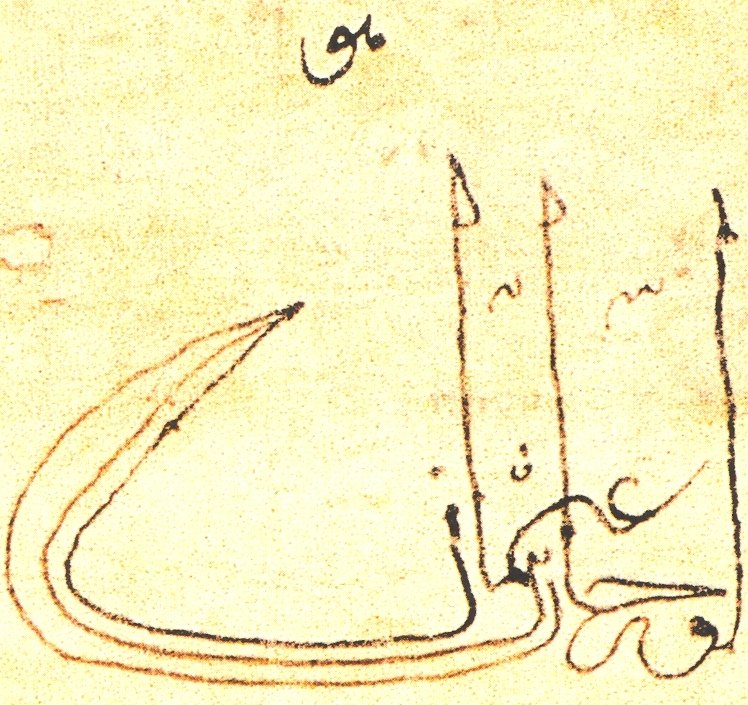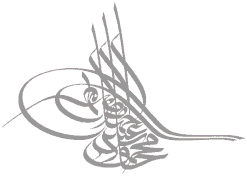Tughra of Abdülhamid II.svg on:
[Wikipedia]
[Google]
[Amazon]
A tughra ( ota, طغرا, ṭuġrā) is a calligraphic  The tughra was designed at the beginning of the sultan's reign and drawn by the court calligrapher or ''
The tughra was designed at the beginning of the sultan's reign and drawn by the court calligrapher or ''
 The tughra has a characteristic form, two loops on the left side, three vertical lines in the middle, stacked writing on the bottom and two extensions to the right. Each of these elements has a specific meaning, and together they make up the form that is easily recognizable as a tughra.
The name of the sultan is written out in the bottom section, called a ''sere''. Depending on the period, this name can be as simple as Orhan, son of
The tughra has a characteristic form, two loops on the left side, three vertical lines in the middle, stacked writing on the bottom and two extensions to the right. Each of these elements has a specific meaning, and together they make up the form that is easily recognizable as a tughra.
The name of the sultan is written out in the bottom section, called a ''sere''. Depending on the period, this name can be as simple as Orhan, son of
File:THES-Heptapyrgion inscription.jpg, Tughra of Murad II at the Heptapyrgion in Thessaloniki (1431)
File:Estambul20100627P1090259.JPG, The Tughra at Dolmabahçe Palace.
File:Eyüp_Sultan_Mosque_-_Door_-_Ottoman_language.jpg
File:İstanbul-Topkapı_palace._-_panoramio.jpg
File:20131204_Istanbul_224.jpg
File:20131204_Istanbul_029.jpg
File:Tughra Suleiman.jpg, Decorated tughra of Süleyman the Magnificent (1520)
File:Tughra of Selim III.JPG, Tughra of

File:Uzun hasan tughra.png, Tughra of Uzun Hasan
File:Тугра Сахиб Герая.jpg, Tughra of Sahib I Giray
File:Naser al-Din Shah stamp.jpg, Tughra of Naser al-Din Shah Qajar
File:Mogultughra.jpg, The official imperial Tughra of the Mughal Empire
Ottoman Sultan Tughras
{{Authority control Islamic calligraphy Ottoman culture Monograms Signature
monogram
A monogram is a motif made by overlapping or combining two or more letters or other graphemes to form one symbol. Monograms are often made by combining the initials of an individual or a company, used as recognizable symbols or logos. A series o ...
, seal or signature of a sultan that was affixed to all official documents and correspondence. Inspired by the tamgha, it was also carved on his seal and stamped on the coins minted during his reign. Very elaborate decorated versions were created for important documents that were also works of art in the tradition of Ottoman illumination, such as the example of Suleiman the Magnificent in the gallery below.
 The tughra was designed at the beginning of the sultan's reign and drawn by the court calligrapher or ''
The tughra was designed at the beginning of the sultan's reign and drawn by the court calligrapher or ''nişancı
Nişancı was a high post in Ottoman Empire, Ottoman bureaucracy. The Turkish word ''nişancı'' literally means "court calligrapher" or "sealer," as the original duty of the nişancı was to seal royal precepts.
History
Although the post of the c ...
'' on written documents. The first tughra examples are from the 14th century.
Tughras served a purpose similar to the cartouche in ancient Egypt or the Royal Cypher of British monarchs. Every Ottoman sultan had his own individual tughra.
Etymology
There are two main schools of thought on the origins of the word tughra. The first sees it derived from a Turkic secretarial emblem called ''tughragh'', and the second as an effort by Persian scribes to shape the name of the ruler into a bow-like element called ''turgha''/''turghay'', subsequently mispronounced as tughra. The primary argument for the first school is a remark byMahmud al-Kashgari
Mahmud ibn Husayn ibn Muhammed al-Kashgari, ''Maḥmūd ibnu 'l-Ḥusayn ibn Muḥammad al-Kāšġarī'', , tr, Kaşgarlı Mahmûd, ug, مەھمۇد قەشقىرى, ''Mehmud Qeshqiri'' / Мәһмуд Қәшқири uz, Mahmud Qashg'ariy / М ...
in his '' Dīwān Lughāt al-Turk'':
Visual elements of a tughra
 The tughra has a characteristic form, two loops on the left side, three vertical lines in the middle, stacked writing on the bottom and two extensions to the right. Each of these elements has a specific meaning, and together they make up the form that is easily recognizable as a tughra.
The name of the sultan is written out in the bottom section, called a ''sere''. Depending on the period, this name can be as simple as Orhan, son of
The tughra has a characteristic form, two loops on the left side, three vertical lines in the middle, stacked writing on the bottom and two extensions to the right. Each of these elements has a specific meaning, and together they make up the form that is easily recognizable as a tughra.
The name of the sultan is written out in the bottom section, called a ''sere''. Depending on the period, this name can be as simple as Orhan, son of Osman Osman is the Persian transliteration and derived from the Arabic masculine given name Uthman ( ar, عُثْمان, , link=no ''‘uthmān'') or an English surname. It may refer to:
People
* Osman (name), people with the name
* Osman I (1258–132 ...
, in the first tughra in 1326. In later periods honorifics and prayers are also added to the name of the tughra holder and his father.
The loops to the left of the tughra are called ''beyze'', from Arabic meaning ''egg''. Some interpretations of tughra design claim that the beyzes are supposed to symbolize the two seas the sultans held sway over: the outer larger loop signifying the Mediterranean and the inner, smaller loop signifying the Black Sea.
The vertical lines on the top of the tughra are called ''tuğ'', or flagstaff. The three tugs signify independence. The S-shaped lines crossing the tugs are called ''zülfe'' and they, together with the tops of the tugs that also look to the right, signify that the winds blow from the east to the west, the traditional movement of the Ottomans.
The lines to the right of the tughra are called ''hançer'' and signify a sword, symbol of power and might.
Tughras of the Ottoman sultans
Selim III
Selim III ( ota, سليم ثالث, Selim-i sâlis; tr, III. Selim; was the Sultan of the Ottoman Empire from 1789 to 1807. Regarded as an enlightened ruler, the Janissaries eventually deposed and imprisoned him, and placed his cousin Mustafa ...
(1789)
File:Berat_za_imam_vo_Sultan_Mehmed_dzamija_vo_Ohrid.jpg
File:Цакафнаме_за_Охризаде_1491.jpg
File:5_Piastres_1327_Mehmed_V_(obv)-8475.jpg
File:Gate of Felicity Topkapi Istanbul 2007 detail 003.jpg, Tughra on the Gate of Felicity at Topkapı Palace
File:EmirganMosque_(3).jpg
File:Port Gate tughra.jpg, Tughra above Port Gate in Belgrade
Belgrade ( , ;, ; Names of European cities in different languages: B, names in other languages) is the Capital city, capital and List of cities in Serbia, largest city in Serbia. It is located at the confluence of the Sava and Danube rivers a ...
Other tughras
Although the tughra is largely identified with the Ottoman Sultans, they have also sometimes been used in other states, such as theQajar dynasty
The Qajar dynasty (; fa, دودمان قاجار ', az, Qacarlar ) was an IranianAbbas Amanat, ''The Pivot of the Universe: Nasir Al-Din Shah Qajar and the Iranian Monarchy, 1831–1896'', I. B. Tauris, pp 2–3 royal dynasty of Turkic peoples ...
, Safavid Empire
Safavid Iran or Safavid Persia (), also referred to as the Safavid Empire, '. was one of the greatest Iranian empires after the 7th-century Muslim conquest of Persia, which was ruled from 1501 to 1736 by the Safavid dynasty. It is often conside ...
and the Khanate of Kazan. Later, tughras were used among the Tatars of Imperial Russia
The Russian Empire was an empire and the final period of the List of Russian monarchs, Russian monarchy from 1721 to 1917, ruling across large parts of Eurasia. It succeeded the Tsardom of Russia following the Treaty of Nystad, which ended th ...
.
The Mughal Emperors are also known to have used calligraphic symbols, alongside the Ottomans
The Ottoman Turks ( tr, Osmanlı Türkleri), were the Turkic founding and sociopolitically the most dominant ethnic group of the Ottoman Empire ( 1299/1302–1922).
Reliable information about the early history of Ottoman Turks remains scarce, ...
, the Mughal "Tughra" was circular in shape with three points at its tip, beside the calligraphic signature of the emperor.
Afghan currency notes from 1919 to 1936 had the tughra present as well. Pakistan had the tughra on it coins from 1947 till 1974; both of these are present in the State Bank Museum in Karachi. The nawab of Bahawalpur and the Nizam of Hyderabad had tugras on their coinage as well. The flowing lines could symbolize the wide reach of Suleyman's rule and his future conquests. It could also signify the spread of Islam to other realms beyond the Ottoman Empire.

Post-imperial interpretations
There are modern artists ofcalligraphy
Calligraphy (from el, link=y, καλλιγραφία) is a visual art related to writing. It is the design and execution of lettering with a pen, ink brush, or other writing instrument. Contemporary calligraphic practice can be defined as "t ...
that use the characteristic tughra form today. Examples are the tughras of Russian president Vladimir Putin and Akihito, the Emperor of Japan, created by artist Vladimir Popov.
See also
* Culture of the Ottoman Empire * Gallipoli Star * Islamic calligraphy *Huaya
A ''huaya'' ("Flower Print"; ; ko, 화압, Hwaap; ja, 花押, Kaō) is a stylized signature or mark used in East Asian cultures in place of a true signature. Originating from China, the ''huaya'' was historically used by prominent figures such ...
, stylised calligraphic signatures used in East Asia
*Khelrtva
A ( ka, ხელრთვა, ) is a Georgian calligraphy, Georgian calligraphic signature, monogram or seal (device), seal, originally used by the List of monarchs of Georgia, Georgian monarchs, List of consorts of Georgia, queens consort, Lis ...
, stylised calligraphic signatures used in Georgia
* Ottoman Emperors family tree
* Ottoman Dynasty
* Ottoman family tree (more detailed)
* Line of succession to the Ottoman throne
*List of sultans of the Ottoman Empire
The sultans of the Ottoman Empire ( tr, Osmanlı padişahları), who were all members of the Ottoman dynasty (House of Osman), ruled over the transcontinental empire from its perceived inception in 1299 to its dissolution in 1922. At its hei ...
* List of Valide Sultans
*Postage stamps and postal history of Turkey
The postal history of Turkey and its predecessor state, the Ottoman Empire, dates to the 18th century when foreign countries maintained courier services through their consular offices in the Empire. Although delayed in the development of its own ...
*Rota (papal signature)
The ''rota'' is one of the symbols used by the pope to authenticate documents such as papal bulls. It is a cross inscribed in two concentric circles. Pope Leo IX was the first pope to use it.
The four inner quadrants contain: " ''Petrus''", ...
* Totem
References
External links
Ottoman Sultan Tughras
{{Authority control Islamic calligraphy Ottoman culture Monograms Signature